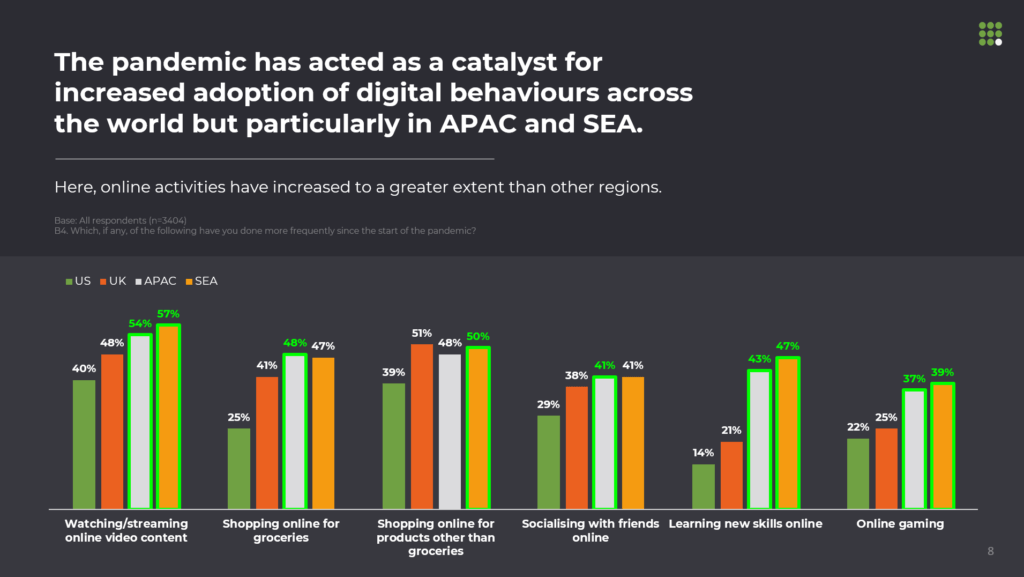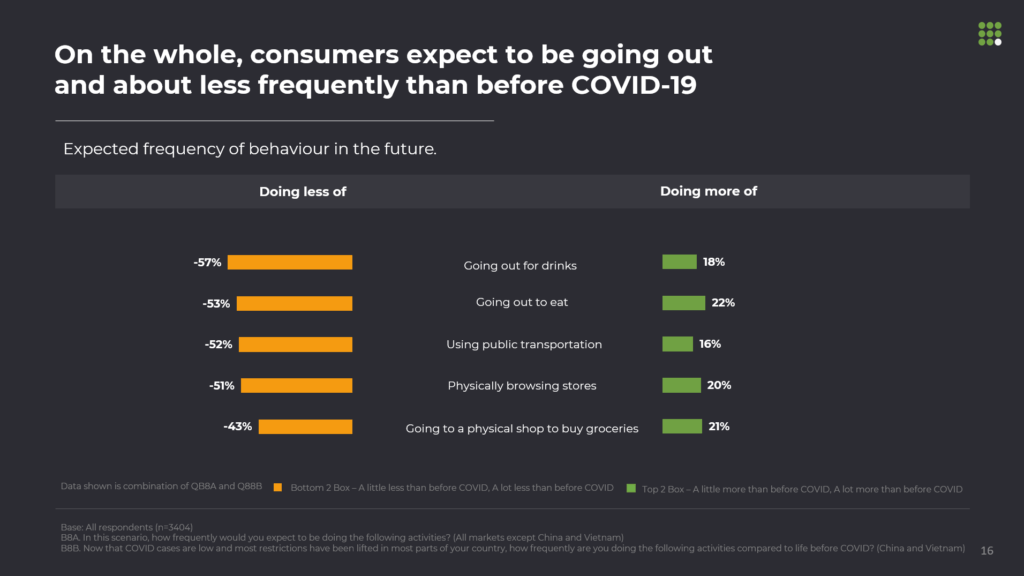Exploring the priorities of APAC’s business decision-makers —past, present, and future
Download the summary of our latest report
The global business community was hit hard in 2020, with COVID-19 creating unprecedented challenges for organizations worldwide.
Supported by Kadence International, Bloomberg Media embarked on a research program with 3800 executive business decision-makers in six markets across APAC —Singapore, Thailand, Malaysia, Hong Kong, Japan, and Australia in waves 1 – 4 and India and Vietnam in wave 5.
Wave 1: 22nd April – 3rd May 2020 (n=714)
Wave 2: 16th – 22nd June 2020 (n=700)
Wave 3: 17th – 25th August 2020 (n=700)
Wave 4: 2nd – 9th November 2020 (n=729)
Wave 5: 5th – 23rd February 2021 (n=969)
Spanning five waves – from April 2020 to February 2021, we’ve stayed with business decision-makers at every step of the way —from the immediate aftermath of the outbreak to the economic reopening and beyond.
Not only does this research provide unparalleled insight into how organizations adapt during uncertain times, but it also helps us anticipate the key trends, challenges, and strategic focus areas for the future, which we will explore in this report.
Overall Business Outlook
The sustained roll-out of vaccines in major economies and more informed knowledge of controlling the virus has led to a positive outlook amongst decision-makers. More than half of the decision-makers (55%) anticipate a recovery period following the uncertainty of 2020.
The pandemic has spurred the speed with which organizations embraced specific ideas and priorities, most notably in the areas of new technology, flexible work, commitment to staff wellbeing, and businesses’ roles in contributing towards a more sustainable and equitable world.
Get more insights into how business decision-makers perceive the overall business landscape here by downloading our free report.
Critical concerns for business decision-makers
For decision-makers, there has been a shift in the focus areas. During the first wave of this research conducted in April 2020, their top three concerns centered around the protection and safety of their employees, guarding against disruptions to business operations, and working capital and funding.
Concerns around protecting employees against disease have remained consistent throughout the five waves; however, other focus areas have shifted. The fear of disruptions to business operations is far less prevalent today as organizations have innovated and painstakingly adapted to continue operating despite challenging conditions.
Focus has shifted to facing the unknown, data security, and overcoming work visas and international travel issues. Compared to the pandemic’s start, more business decision-makers cite facing the unknown as a critical concern. Data security has come into sharper focus as a result of working conditions in the new normal.
For 68% of the decision-makers, overseas business travel is either very or of utmost importance for meeting new and prospective clients and for training and development. This has brought the importance of mitigating work visas and international travel challenges posed by the pandemic.
As decision-makers actively follow COVID news coverage to navigate the challenges posed by the pandemic, news organizations have played a significant role in supporting businesses. With 77% of business decision-makers telling us they use their smartphone more often to follow the news, we see smartphones playing an increasingly important role in accessing information.
Get more in-depth analysis of the most significant business concerns for decision-makers. Download our free report here.
Priorities for the future —Harnessing technology is a top priority.
In the final research wave, we asked decision-makers to reflect on how their priorities have changed now compared to before the pandemic. Digital transformation was the predominant theme as businesses have had to make rapid changes to ride the pandemic and survive it. In fact, 82% attribute their company’s increased prioritization of digital investment to COVID-19. This is not a short-term trend, and decision-makers will continue to harness technology for their companies in the future.
According to the report, 77% expect their company’s overall technology budget to increase in the next 1 to 3 years.
So, where do companies expect to be investing their digital spending? IT support tops the list as organizations recognize the importance of securing and installing new tools.
Download our full report to find out what other areas are envisioned for increased tech budgets in 2021 and beyond.
Attitudes towards foreign investment
In the near future, business decision-makers are most confident that Singapore, Australia, New Zealand, and Japan are the markets they would like to invest in.
This is because these top five countries are perceived to prosper across four critical pillars of market confidence: political stability, economic reopening, virus containment, and society’s resilience.
Discover how APAC business decision-makers rate the factors that will play a critical role in informing which foreign countries to invest in the future by downloading our free report.
The role of the office
The pandemic caused a significant shift in the office’s role, with many companies moving fully remote and others offering the flexibility of a hybrid work model.
Read the full report to learn what percentage of companies allowed the flexibility to work from home or office over the three waves.
Flexibility is not limited to where people work from, but also the hours they work. Working from home during the pandemic meant juggling household responsibilities, like childcare while schools were closed. Again, this trend is not short-term as many companies have made flexible work a part of their long-term strategy.
Flexible work has not been without its share of challenges. Therefore, decision-makers are adopting new tools and methodologies.
Find out which areas companies are focused on developing and how they are planning to overcome post-pandemic human resource challenges by downloading our full free report.
People Management
There has been an emphasis on physical and mental health both in their personal and business lives. Throughout the research, decision-makers have placed health and wellbeing on top of their list, considering it more important than their career and business, financial stability, and even relationships with family and friends.
According to the research, 79% of business decision-makers say that their company has become more aware of safety, personal values, and their employees’ wellbeing.
Read the full report to find out how decision-makers are translating this awareness of the health and wellbeing of their employees and how they plan on continuing to increase investments in their company’s healthcare and wellness programs.
Decision-makers have also made helping employees manage their mental health a priority.
Companies are increasingly engaging with an expert or vendor to provide healthcare/wellbeing training or services for their staff. According to the research, this percentage has jumped from 55% in wave 4 (November 2020) to 66% in wave 5 (February 2021).
Businesses are considering several options to support staff, but mental health and stress management are on top of their list, with almost half (49%) of firms considering this.
Discover the other top areas considered to enhance the company’s corporate wellness program by downloading our free report here.
Aligning personal and business values
The pandemic experience has caused many people to re-evaluate what’s important to them, extending to the world of business.
According to the research in wave 5 (February 2021), 75% of business decision-makers say they have placed greater emphasis on giving back to society.
Not only is an increasing focus on altruism informing business strategy, but it’s also influencing brand choice.
Read the full report to discover the two most prominent social causes that are the focus of decision-makers.
After witnessing what might be the most challenging year in recent history, there’s a sense of optimism from APAC’s business decision-makers.
With new shifts in the way we work and feel, there are evolving challenges. However, flexibility, wellbeing, and altruism are here to stay long-term, allowing business decision-makers to align their values with their commercial goals.
In this research, we take a deep dive into major focus areas within each trend and discover what decision-makers consider their top priorities in the near future. If you need more detailed information to help make decisions for your organization or brand, download the full report here.











 Senior Marketing Executive
Senior Marketing Executive Sales & Marketing
Sales & Marketing Vital Strategies
Vital Strategies
 Customer Intelligence Director
Customer Intelligence Director